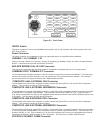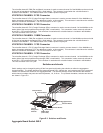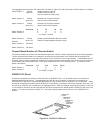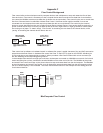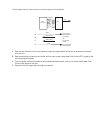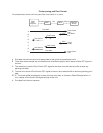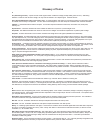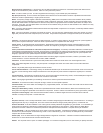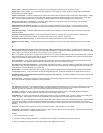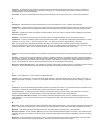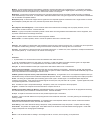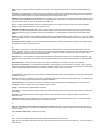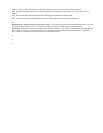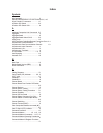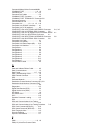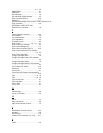Device driver: Software that controls how a computer communicates with a device, such as a printer or mouse.
Digital signal: Digital devices, such as terminals and computers, transmit data as a series of electrical pulses which have discrete
jumps rather than gradual changes.
Digital Transmission: A method of electronic information transmission common between computers and other digital devices. Analog
signals are waveforms: a combination of many possible voltages. A computer's digital signal may be only "high" or "low" at any given
time. Therefore, digital signals may be "cleaned up" (noise and distortion removed) and amplified during transmission.
DIP switch (pronounced "dip switch"): A set of tiny toggle switches, built into a DIP (dual in-line package), used for setting
configurable parameters on a PCB (printed circuit board).
DPSK (Differential Phase Shift Keying): A common form of phase modulation used in modems. It does not require complex
demodulation circuitry and is not susceptible to random phase changes in the transmitted waveform, thus reducing errors during
transmission.
DSR (Data Set Ready): An RS232 signal sent from the modem to the computer or terminal indicating that it is able to accept data.
Contrast with DTR.
DTE (Data Terminating Equipment): A term used to include any device in a network which generates, stores or displays user
information. DTE is a telecommunications term which usually refers to PCs, terminals, printers, etc.
DTMF (Dual-Tone MultiFrequency): A generic push-button concept made popular by AT&T TouchTone.
DTR (Data Terminal Ready): An RS232 signal sent from the computer or terminal to the modem indicating that it is able to accept
data.
E
EBCDIC (Extended Binary Coded Decimal Interexchange Code) (pronounced "eb suh dick"): An IBM character code used in its
mainframe and midrange computers. It is an 8-bit code (256 combinations) that stores one alphanumeric character or two decimal digits
within a byte. This code and ASCII are the most commonly used to represent data.
Echo: The reflection or duplication of a signal back toward its source. Echoing is useful when a terminal is transmitting data, in that the
data can be echoed to the screen so the user can monitor what is being sent. Echoing is undesirable when it refers to the signal which
results on a telephone line from impedance mismatches.
Echo cancellation: A high speed modem technique that isolates and filters out unwanted signals caused by echoes from the main
transmitted signal. This allows full-duplex modems to send and receive on the same frequency carrier.
EIA (Electronics Industries Association): A membership organization founded in 1924 that includes manufacturers of electronic parts
and systems. With over 1200 members, it sponsors shows and seminars and gives awards for outstanding contributions in electronics.
It sets electronic interface standards, such as RS-232.
Environment: A computer configuration that includes the CPU model and system software (operating system, data communications
and database systems). It may also include the programming language used. It sets the standards for the applications that run in it.
EPROM (Erasable Programmable Read Only Memory) (pronounced "eeprom"): A reusable PROM chip that holds its contents until
erased under ultraviolet light.
Error correction: The process of detecting distorted data bits and requesting a retransmission or interpretation to correct the error.
Errors are introduced by bad line conditions or external interface.
F
Fax (facsimile): Refers to the bit-mapped rendition of a graphics-oriented document (fax) or to the electronic transmission of the image
over telephone lines (faxing). Fax transmission differs from data transmission in that the former is a bit-mapped approximation of a
graphical document and, therefore, cannot be accurately interpreted according to any character code.
Firmware: A category of memory chips that hold their content without electrical power, they include ROM, PROM, EPROM and
EEPROM technologies. Firmware becomes "hard software" when holding program code.
Flash Memory: A memory chip that holds its content without power, but must be erased in bulk. The term comes from its ability to be
erased "in a flash". Flash memory is derived from EEPROM, but are less expensive and provide higher bit densities.
Flow control: The process of regulating the speed at which data enters or leaves a serial port. Software flow control is implemented by
communications software or by the user sending predefined characters or packets which are recognized as "pause" and "resume"
indicators. Hardware flow control is achieved by using the RTS (request to send) and the CTS (clear to send) control lines of the RS232
interface.
Footprint: The desk or floor surface that a piece of hardware occupies. Also referred to as "real estate".
Foreground: The application program currently running on and in control of the PC screen and keyboard. The area of the screen that
occupies the active window. Compare with background.
Format:
1. The way text is set up on a page.
2. To prepare a disk for holding information. Formatting a disk can delete all information that was previously on it.
3. The way information is structured in a file, often specific to one application or protocol.



